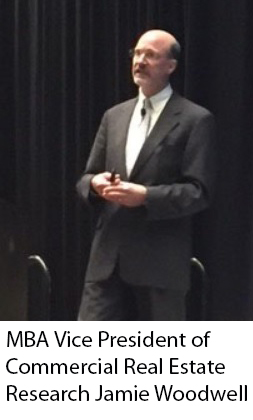
Predicting the Evolving Future of Commercial Real Estate
MIAMI–Commercial real estate looks different today than just a few years ago–and it will look very different in the near future, MBA Vice President of Commercial Real Estate Research Jamie Woodwell said.
Speaking here at the MBA Commercial/Multifamily Servicing and Technology Conference 2018, Woodwell speculated as to what real estate finance might look up to 10 years in the future. “There is a creed economists like to use,” he said. “If you give a number, don’t give a date. If you give a date, don’t give a number. And if by accident you give both and you are right, don’t act surprised. But think back just 10 or 11 years; the iPhone had not been invented yet. So the sky is the limit for 10 years from now. There is a lot that can change in the mortgage process in 10 years.”
Woodwell noted HSBC recently announced the world’s first finance transaction using Blockchain, a digital ledger that records transactions across many computers so the record cannot be altered. “I think it’d be a mistake to assume the mortgage world will be the same 10 years from now,” he said.
The industry saw significant changes very recently, when President Trump signed tax reform legislation in December, Woodwell said. “That made some pretty fundamental changes to the tax rate structure,” he said. “There was talk of eliminating the deductibility of business interest; that would have been dramatic to the commercial real estate finance industry. For most sectors, that is now the law of the land, but there was an exemption made for CRE because that’s not how our industry works.”
Woodwell noted 1031 like-kind exchanges changed for many parts of the economy with last year’s tax reform act, but not for commercial real estate.
The income tax changes will likely be a net positive for the economy for the next few years, Woodwell said. “Overall, for the next year or two, MBA expects to see good solid growth. The benefits of tax reform will help, but there is also an incredibly tight job market and we’ve had years of strong job growth, which is starting to work its way into wage increases for employees. And that leads to increasing consumer confidence.”
Looking three years ahead, Woodwell observed that just three years ago Newsweek magazine predicted Jeb Bush or Hillary Clinton would likely win the White House in 2016. “In three years from now, we might have a very different person in the White House–or we might not,” he said. “A lot of changes could take place there. But between now and then we are going to have a very long time of campaigning. Different groups will try to define where the country is heading. That conversation will definitely color the economy.”
Woodwell noted multifamily vacancy rates recently stood at their lowest point since the mid-1980s. “There is strong rent growth, property values are increasing and there is strong NOI growth,” he said. There are also more multifamily units under construction right now than at any time since the mid-1970s, he said. “That’s really a story about the footrace between supply and demand over next few years.”
Woodwell said office space needs per employee have shrunk for several years and will likely continue to shrink going forward. “It’s not a question of supply versus demand for office space but demand for office space versus changes in demand for it,” he said. “The country continues to add jobs and there is a strong increase in the number of laborers in the workforce, but on the other side, there is greater use of space and increasing telework, so it’s a moving target. Without a doubt, this is a big piece we need to keep our eyes on.”
While the percentage of sales made online grew from 9.1 percent in 2016 to 9.5 percent last year, that does not mean brick-and-mortar retail properties will go away in the next few years, Woodwell said. “There is just a shift between how people are mixing them. Sales can improve if the firm has an omnichannel approach with both bricks and clicks going on at the same time.”
With interest rates starting to rise, the spread between 10-year Treasurys and the rate people have demanded to invest in CRE has started to close, Woodwell said. He cited shrinking spreads on commercial mortgage-backed securities, corporate bonds and commercial property cap rates as interest rates have increased.
MBA expects interest rates will continue to rise over the rest of the year. “We see the economy really getting traction, and inflation kicks in with wage growth,” Woodwell said. “But because investors had already expected rates to increase, it won’t have as big an impact as it would if it were a surprise.”
